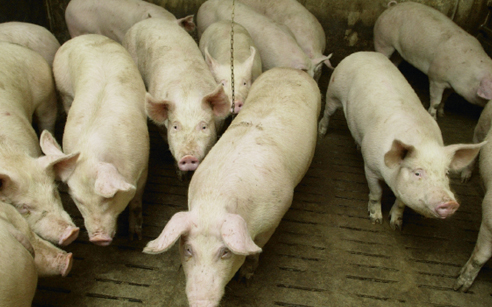New feed ingredients affect carcass fat quality

As the quantity of Distillers Dried Grains with Solubles (DDGS) increased in pig rations so has the concern over fat quality. It is well known that the use of DDGS increases the amount of unsaturated fat in rations. This has the potential to negatively influence carcass fat quality since carcass fat composition is affected by the type of fat in the diet.
Increasing the concentration of unsaturated fatty acids in pork carcasses results in softer fat and this can affect carcass processing characteristics. The iodine value (IV) of a fat source is an estimate of the proportion of unsaturated fatty acids in that source of fat. Carcass iodine value is an indirect indicator of the percentage of unsaturated fatty acids or the softness of fat in the carcass. Typical acceptable ranges of IV in backfat ranges from 70 to 75g/100 g fat. At least one US packing plant is using a maximum IV of 73 g/100 g fat to determine acceptable carcass quality. Typically this is done using jowl fat samples since they are easy to collect and do not affect the value of other cuts.
However, it is unclear whether jowl fat IV is a good indicator of fat quality for the whole pig. Equations have been developed to predict the iodine value of backfat using dietary fat content and the iodine value of the dietary fat source. This calculated value is called iodine value product (IVP) and is a function of the iodine value of dietary lipids and concentration of dietary lipids. However, the data used to determine the validity of IVP as it relates to carcass quality is quite limited.
Fat quality study
A recent study by Benz et al. (2011) aimed to examine the effect of feeding different levels of dietary IVP on the carcass fat quality of finishing pigs. In this study they used three different fat sources, extruded expelled soybean meal (EESM), Distillers Dried Grains with Solubles (DDGS) and choice white grease (CWG), to create a three phase feeding program of low, medium and high dietary IVP diets (examples of which are presented in Table 1).
The diets were fed to 120 crossbred barrows over an 83 day experimental period. At the end of the trial pigs were slaughtered at a commercial processing plant and fat samples were taken from jowl and backfat.
As expected, the results of this study demonstrate that the addition of ingredients high in unsaturated fats, such as DDGS and EESM, changes the proportion of fatty acids in fat tissues and that soft carcass fat is a direct result of the high dietary linoleic acid (C18:2n-6) and polyunsaturated fatty acid (PUFA) concentrations.
The researchers found that IVP was not an accurate predictor of carcass fat IV when dietary fat differed in concentration and degree of unsaturation (Figure 1). In addition, regardless of the dietary IVP the IV backfat and jowl fat was less than 73g/100 g of fat and for most treatments well below this value. Interestingly, the researchers found that the calculated dietary linoleic acid concentration was a much better predictor of back fat and jowl fat IV. This is likely due to the fact that linoleic acid is the most abundant fatty acid in pork fat and is mainly derived from dietary fat sources. This may have some practical application in diet formulation as we push DDGS levels higher in diets and should be explored further.
Jowl fat different to backfat
Another interesting outcome of this study was that it looked at the appropriateness of using jowl fat IV to determine carcass fat quality. In the study as expected, both backfat and jowl fat IV increased in pigs fed dietary ingredients with higher unsaturated fats (i.e. DDGS and EESM) compared with pigs fed the control diet. However, the average increase in jowl fat IV was only 65% of the rate of the change in backfat IV when compared to the control. This suggests that although the trend in IV changes of the two fat depots is similar, the magnitude of the response may be different.
As a result, while jowl fat IV may be able to predict the general trend in IV change, in other fat depots it does not accurately predict backfat IV. A study by Evans et al. (2009) observed that backfat and intramuscular fat were better indicators of belly IV than jowl fat. This difference in fatty acid composition between tissues may partially be explained by differences in fat development and the presence of structural lipids in muscle which are not as readily affected by diet. Consequently, processors may need to re-examine the practice of using jowl fat IV to determine carcass fat quality in the future.











